Vietnamese Sweet Lemon Curry Soba Noodle Tofu Salad
- At September 10, 2016
- By megan
- In carrot, curry, Farm to Table, favorites, garlic, local foods, noodles, Recipes, Savory Spice Shop, tofu, tomatoes
 0
0
If I’m going to enjoy tofu, it HAS to have been frozen, thawed, and pressed before being seasoned and cooked. Freezing tofu changes the texture into something I almost find enjoyable, so there’s always a block sitting in our freezer. This cold soba noodle salad with tofu, locally grown carrots, peppers, and tomatoes, and fried garlic is well worth repeating.
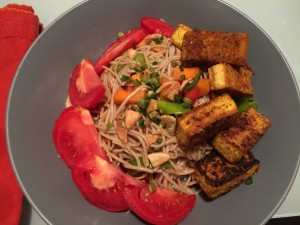
Here’s how I made it.
First, the thawed tofu needs to be pressed to expel excess liquid. I usually wrap it in a few layers of paper towels and gently squeeze it, being careful not to squeeze too hard and tear the block. Then it’s ready to be cut into bite-sized pieces and marinated. I chose a dry rub since it was going to be fried. Wet marinades make for quite a mess when it hits hot oil. Lesson learned!
The tofu was generously seasoned with Vietnamese Sweet Lemon Curry from Savory Spice Shop and then pan fried in peanut oil until crispy on all sides. The secret to getting a nice crust on each side is having a hot pan, hot oil, and not checking the food to see if it’s cooked, but waiting until it’s fully seared before flipping it. The chef-husband had to lecture me a few times on this before I listened, and what a difference it makes! Gone (hopefully) are the days of tofu sticking to the pan and breaking apart when it’s flipped, leaving smaller pieces to burn and stripping the tofu of it’s coating (read: flavor). After each side gets a crust, just remove them and let them cool.
Next, a chopped carrot and green pepper from the Boulder Farmer’s Market went into the peanut oil pan to heat them ever so slightly. I boiled soba noodles according to the instructions on the package and then rinsed them in cold water to keep them from cooking, fried some garlic until crispy, chopped a jalapeño, and sliced a tomato.
I tossed the cold noodles with sesame seeds and the carrot and pepper pieces, and then drizzled some toasted sesame seed oil, fresh squeezed lemon, soy sauce (I prefer the unpasteurized Nama Shoyu brand), and a little local honey. Finally, I added diced jalapeño and crispy fried garlic for an extra crunch and kick.
I HOPE Hummus
- At July 24, 2016
- By megan
- In appetizer, Boulder Farmers Market, curry, favorites, Hummus, local foods, snack
 0
0
I was invited to visit Hope Foods, maker of the incredibly fresh and delicious Hope Hummus, in Louisville, Colorado. I’ve seen the name around for a few years now, but I can’t recall ever purchasing one of their products before. I knew that they started selling hummus at the Boulder County Farmers Market, and I knew they’d expanded and were on shelves in a number of our local grocers, but that’s the most I could have told you before last week. Now I could talk your ear off about what a great local company they are and how Hope Hummus should be your hummus of choice if you’re not making it from scratch at home. It will certainly be my go-to when I’m not following Chef Mike Solomonov’s recipe, which is a very traditional Israeli hummus. In fact, I was so inspired by my visit to Hope Foods that I’ll likely tweak chef Solomonov’s recipe the next time I make it.
~Inspiration to create new flavors of garbanzo bean spread~ That’s what came to me on our media party at Hope Foods. We were given two bowls of hummus, a “regular” or savory one and a sweet one that was sweetened with agave syrup. There was a table of ingredients full of spices, herbs, jams, nut butters, pumpkin, roasted peppers, lemons, limes, coconut flakes, goji berries…you name it and it was likely on a table for us to mix our own flavored hummus.
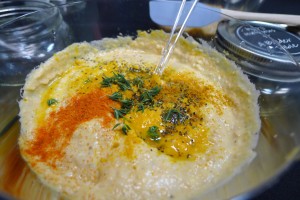
I added pumpkin puree, curry powder, cayenne pepper, turmeric powder, lemon juice, fresh thyme and ground black pepper to my savory bowl. Then mixed it all together and scooped it into a Ball jar labeled for A Bolder Table, which was a nice touch 🙂
Next up was the sweet hummus, which I wasn’t really sure what I’d enjoy, so I kept it simple: Almond butter and blackberry jam.
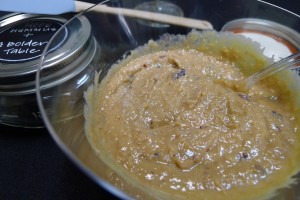
This combination would go really well on toast, and I would have NEVER thought of sweetening hummus on my own, so I’m inspired to try a variety of combinations in the future.
After mixing up some unique spreads, we were given a tour of the 15,000 square foot hummus factory, and learned that Hope Foods doesn’t make a ton of hummus and store it until an order comes in. They make hummus to order, so there’s a two day turn-around time from when they make the hummus to when it’s loaded on a truck for delivery. That’s FRESH in my opinion. It’s also Cold Pressure Prepped, which means it needs neither preservatives nor high heat to ensure each batch is safe from pathogens, bacteria, and mold. Another important detail that sets them apart from their competitors is adding olive oil rather than canola oil to their hummus. In short, Hope Foods makes fresh hummus using as few ingredients as they can without skimping on ingredient quality to produce a large quantity of food. I can stand behind that.
An operation that started with a group of friends making hummus in a commissary kitchen and selling it at the farmers market now employs 30+ people and makes more than ten different flavors of hummus. In my opinion, this company is doing everything right, and I am proud to have them as a local producer here in Colorado. I hope they continue to spread good things.
Lotus of Siam, Las Vegas
- At October 9, 2015
- By megan
- In curry, Restaurant Review
 0
0
Over the past few years I have heard so many people tell me that if I wanted truly authentic Thai food I needed to go to Lotus of Siam– a James Beard award winning restaurant in a mini mall in Las Vegas. As someone fortunate enough to have spent a few months in Thailand in my early twenties, I’ve had a hard time enjoying Thai food here in the US ever since. So, 2015 was the year to go to Vegas and try it out.
And, like most things that have been overly hyped by your friends, it was a bit of a disappointment and I wouldn’t go back. Don’t get me wrong here. The food was good, the service was good, and we had a good dining experience. But, I had expected so much more. I was expecting it to be more of an “authentically authentic” Thailand-type-of-food than we experienced. They did, however, have an excellent wine list to accompany their cuisine.
Lotus of Siam frequently has a two+ hour wait to get in. We got there as soon as they opened to avoid their infamous line, which was definitely a good idea given the mini mall scenery and the dessert heat.
While Sean perused the wine list, I started perusing the very large menu. This is where I first got weary. The menu is long. There are so, so, so many options. It’s the type of menu that covers everything and often has the same dish in a slightly different iteration on the next page. That was my first red flag. Right away I thought of the classic Southeast Asian saying, “Same Same but Different.” Over there, it’s like a joke amongst backpackers going through so many neighboring Asian countries. Over here, it felt like I was in a nondescript Chinese restaurant with a menu item that aimed to please everybody. In Thailand, however, menus are brief. Lotus of Siam claims to be northern Thai. There’s no way acclaimed restaurants in northern Thailand offer such an eclectic menu. It just doesn’t happen.
We ordered some egg rolls, tempura veggies and shrimp, and a bottle of wine to start. The wine was excellent, the egg rolls were fine, and the tempura veggies and shrimp were very unimpressive. There was so much breading, so little flavor, and it’s really not a traditional Thai dish in the first place. Nor were the egg rolls. In hindsight, writing this, I wonder why we ordered them? We were hungry.
We ordered a cup of spicy veggie soup, which was good. We ordered a vegetarian mushroom dish, which was absolutely terrible, and we sent it back. It was a mound of cold mushrooms in the middle of a plater of raw sliced vegetables. They took it off of our bill, which was expected, but we were glad to confirm that upon receiving the bill. I enjoyed my catfish curry, but the highlight for me was the sticky rice I ordered in addition to the curry. It was almost identical to the Chiang Mai region’s sticky rice, minus the presentation.
In northern Thailand, sticky rice is served in dried bamboo grass. At Lotus of Siam, it’s in plastic inside a basket. Which brings me to my main point here- I’m not just trying to write something negative for the sake of complaining. I’m simply not convinced that Lotus of Siam is all that amazing. If and when you get yourself over to Thailand, you’ll say to yourself, “OMG this food is so amazing! I can’t believe how much better it is than the Thai food we eat in the US.” Stay there long enough and you try all kinds of cuisines from Bangkok, to Chiang Mai, Chaing Rai, Sukhothai, Kanchanaburi or Mae Hong Son. For Lotus of Siam to be such an acclaimed establishment seems ludicrous to me as eating there offers very little of a truly Thai dining experience.
Pumpkin Peanut Curry Soup
Every autumn I have a craving for my pumpkin peanut curry soup. I make it once or twice and then wait until pumpkins are in season the following year before making it again. Each time it comes out slightly differently depending on how much of this or that goes in it. Here’s what I did this time-
I roasted a locally grown pumpkin the size of a soccer ball at 375 for 30 minutes or so… I must admit, I totally lost track of time. I have NO idea how long that pumpkin was in there. I’d say 30-40 minutes. I do know, however, that I cut it in half, seeded it (and saved the seeds to make Mexican Mole Roasted Pumpkin Seeds), covered the flesh in butter, and placed it cut side down into a pyrex baking dish with a cup or so of brandy. I am sure of that part.
While the oven was preheating for the pumpkin, I toasted a cup or so of unsalted peanuts. Watch them! It’s really easy to over-toast (burn) nuts. Keep an eye on them and get them out of the oven when they’re starting to brown and smell like roasted peanuts.
But, before I even put the peanuts in the pre-heating oven, I had a thinly sliced sweet yellow onion sautéing on medium-low in some of the coconut fat skimmed from the top of an undisturbed can of coconut milk. I let this start to caramelize while roasting the pumpkin. In the last 15 minutes or so I added a peeled, sliced apple.
So, when the peanuts were done, I put them in the Vita-Mix and made a little peanut butter. Let’s all cheer for the power of that Vita-Mix. What a rockstar appliance. The next step is to blend all of the soft pumpkin flesh, onion, and apple with a can of coconut milk and a cup or so of water into the peanut butter. Start on low, slowly turn it up to 10, then high, and then you’re ready to pour it into a pot and get it on the stove.
This is where the fun seasoning starts. I added a few tablespoons of soy sauce, Kecap Manis (called sweet soy sauce- it is palm sugar syrup, like molasses, but from palm), Vietnamese Sweet Lemongrass Curry (available at Savory Spice Shop), and some cayenne. I let the soup simmer on medium for a while and added some thinly sliced kale that cooked down to be nice and tender after 20 minutes.
Just blogging about this now makes me want to eat another bowl. The creamy peanut-coconut combination is a nice compliment to pumpkin. It brings me back to a small kitchen in Siem Reap, Cambodia, where I had my first pumpkin peanut curry soup. Enjoy!

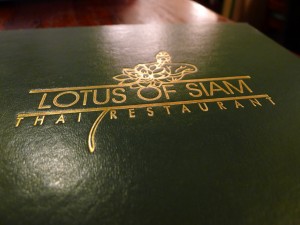
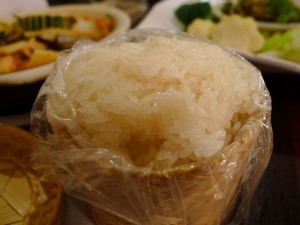
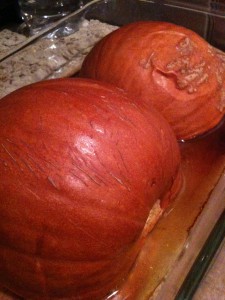
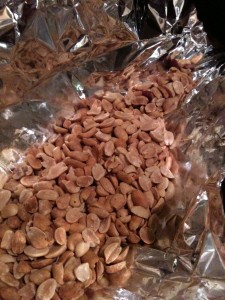
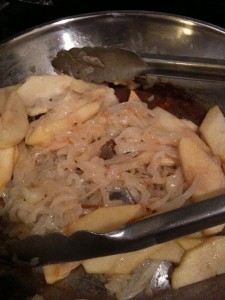
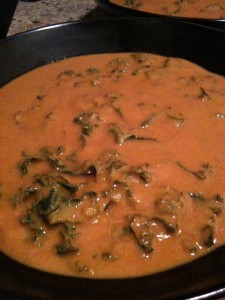
Let’s get Social